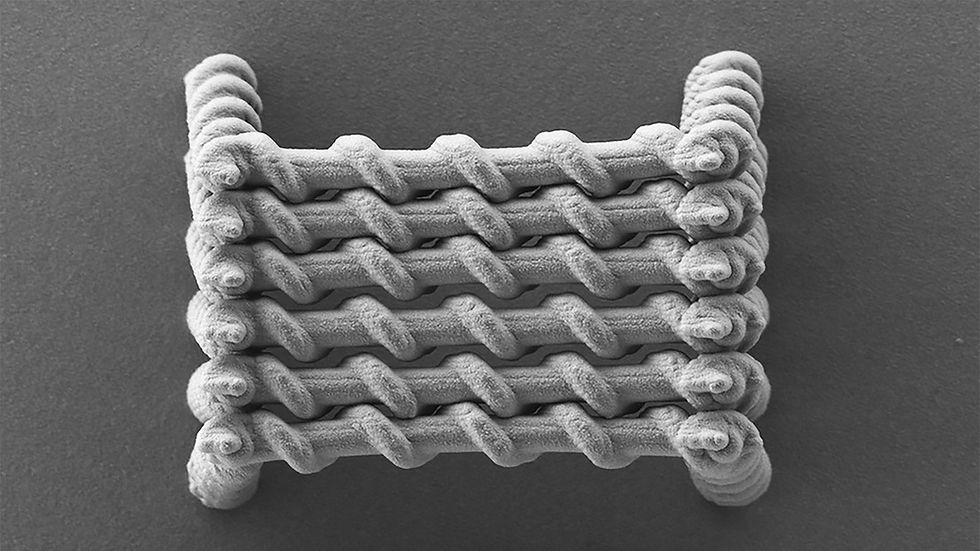Dual-gated single-molecule field-effect transistors beyond Moore’s law
- Marine Le Bouar

- May 30, 2022
- 3 min read

Less than a decade after the realization of the first integrated circuit in 1958, Intel co-founder Gordon Moore made the observation that the number of components in integrated circuits had doubled every year and forecasted that this rate would continue for the foreseeable future. This prediction has been amended and restated in various ways (Moore himself updated it to a doubling every two years in 1975), but the basic idea has always held true: the number of components per integrated circuit increases exponentially, or, as a corollary, the size of transistors decreases exponentially allowing ever more of them to be crammed onto a single chip.
Starting at around 10 micrometers in 1971, transistors have been scaled down steadily by a factor of 1000 over a few decades by semiconductor giants like Intel. At present, TSMC and Samsung are even mass producing 5nm node chips. This remarkable rate of progress shows no sign of faltering; TSMC is planning to sell 3nm node technology in 2023 and 2nm node technology in 2024, with Samsung tailing closely behind. Although Moore’s law will likely hold in the coming years, the trend will halt as we will soon reach the single-atom scale. Researchers are thus urgently considering alternatives to complement or replace conventional solid-state electronics.
One candidate that has shown significant promise is molecular electronics. The idea is that one could leapfrog decades of scaling-down semiconductor technology by creating atomic scale components made of single molecules, i.e. adopting a bottom-up rather than a top-down approach. However, fabricating molecular transistors reliably remains difficult to this day, and the technology is far from the industrial readiness of semiconductor node technology. Nevertheless, molecular electronics is an active field of research being also a useful platform for studying chemical reactions at the single molecule level, molecular light emitting diodes, molecular solar cells, and other technologically important systems.
In a recent paper entitled Dual-gated single-molecule field-effect transistors beyond Moore’s law [Nature Communications 13, 1410 (2022)], Meng and collaborators reported fabrication of a solid-state single-molecule field effect transistor (FET) using graphene source/drain electrodes and a metal back-gate [2], the FET channel is a single dinuclear ruthenium-diarylethene (Ru-DAE) complex connected covalently with nano-gapped graphene electrodes. The use of graphene electrodes was key to the robustness of the device architecture. “The atomic stiffness, controllable morphology, superior electronic properties, molecular-size compatibility and natural end-functionalities make graphene an ideal low-dimensional electrode material having the capability of covalently integrating individual molecules as the conductive channel into electrical nanocircuits to solve the key problems of fabrication difficulty and poor stability of molecular devices” says Prof. Xuefeng Guo, a corresponding author of the study.
The FET operation was demonstrated with a maximum on/off ratio exceeding three orders of magnitude, which compares favorably with other molecular FETs having either low on/off ratios (generally under 10) or operate only in solution-based conditions. Another important FET metric is on-state current, which is inevitably lower in molecular electronics. While the reported values are relatively high for a molecular FET, they remain rather low. “Through molecular engineering, we have plenty of room to design and synthesize molecules with controllable conjugation and polarization and hence improve the on-state current” says Prof. Xuefeng Guo. The operating frequency could also reach the GHz range, comparable to state-of-the-art silicon-based transistors.
The study was a joint experimental/theoretical investigation. The experimental device was simulated by carrying out density functional theory (DFT) within the nonequilibrium Green function (NEGF) formalism, as implemented in the NEGF-DFT quantum transport package NanoDCAL [3], see Figure 1 above. The charge transport calculations reveal how the applied gate voltage effectively tunes the energy level of the conducting molecular orbital thereby promoting the conductance of the Ru-DAE channel. The first principles simulation results are consistent with the experimental observations of the significant FET on/off ratio and its high-performance [2].
Interestingly, the device functionality does not stop there. The Ru-DAE preserves its intrinsic photo-isomerisation property, which enables a reversible photo-switching function. Even though their device does not function as a photoswitching-based FET, this is also a principle that could be exploited in further studies according to the authors. To improve its functionality as a FET, however, molecular engineering will be necessary to address the short channel effect, design new molecular conductors and develop new device architectures. Let us conclude on these words from Prof. Xuefeng Guo: “Although molecular FETs are still in their foundational stage, I believe that they are complementary with current Si-based microelectronics and will have an important role in daily life and enter consumer electronics in the future.”
[1] A. Aviram and M.A. Ratner, “Molecular rectifiers”, Chem. Phys. Lett. 29, 277 (1974).
[2] L. Meng, N. Xin, C. Hu et al., “Dual-gated single-molecule field-effect transistors beyond Moore’s law”, Nat. Commun. 13, 1410 (2022).
[3] J. Taylor, H. Guo, and J. Wang, “Ab initio modeling of quantum transport properties of molecular electronic devices”. Phys. Rev. B 63, 245407 (2001).
Nat. Commun. 13, 1410 (2022)




























Comments